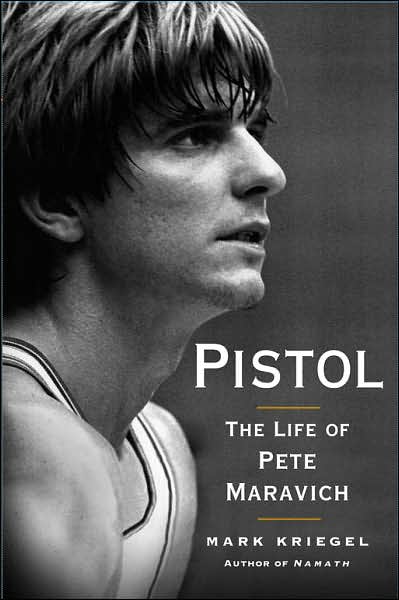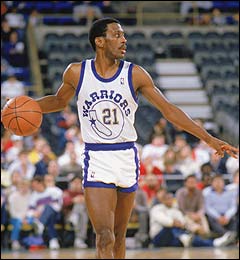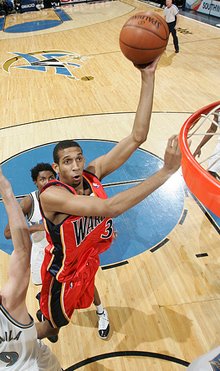
I was searching through YouTube to find any videos showing proper shooting mechanics that I could teach my kids and came across these excellent videos featuring one of the greatest to ever play the game, Pistol Pete Maravich. Click on each of the 6 videos below to learn from the master.
Basketball Shooting 1 (The Setup)
- Fingers
- Hand Position
- Elbow and Arm
- Left Hand
Basketball Shooting 2 (Mechanics)
- The Wrist
- The Gun Barrel
- The Target
- Ball Arc
- Review
Basketball Shooting 3 (Mechanics II)
- The Open Window
- Body Positioning
- Elbows
Basketball Shooting 4 (Psychology)
- Conceptualization
- Concentration
- Confidence
Basketball Shooting 5 (Application)
- The Jump Shot
- The Layup
Basketball Shooting 6 (Recap)
- The Recap
- Trick Shots
Here's the great one in action:
Ultimate Pistol Pete Maravich MIX
by On Parr
Full Name: Peter Press Maravich
Born: 6/22/47 in Aliquippa, Pa.
Died: 1/5/88
College: Louisiana State
Drafted by: Atlanta Hawks (1970)
Transactions: Traded to New Orleans, 5/3/74; Signed with Boston, 1/22/80 Nickname: Pistol Pete
Height: 6-5; Weight: 200 lbs.
Honors: Elected to Naismith Memorial Basketball Hall of Fame (1987); All-NBA First Team (1976, '77); All-NBA Second Team (1973, '78); All-Rookie Team (1971); Five-time NBA All-Star; One of 50 Greatest Players in NBA History (1996).
Career Statistics
G FG% 3PFG% FT% Rebs RPG Asts APG Stls Blks Pts PPG
658 .441 .667 .820 2,747 4.2 3,563 5.4 587 108 15,948 24.2
Pete Maravich Bio from NBA.com:
NBA Hall of Famer "Pistol Pete" Maravich was a spectacular showman who helped open up the game of basketball in the 1970s. After a legendary college career at Louisiana State, he played 10 productive seasons in the NBA, earning five trips to the NBA All-Star Game and one league scoring title.
Maravich wasn't the first player to dribble behind his back or make a deft between-the-legs pass. But his playground moves, circus shots, and hotdog passes were considered outrageous during his era and, perhaps because he cultivated a freewheeling image, some basketball purists felt he was more style than substance. But Maravich produced huge numbers, first as the all-time leading scorer in NCAA history and later as a potent force for both the Atlanta Hawks and the New Orleans Jazz.
Maravich was born on June 22, 1947, in Aliquippa, Pennsylvania. He was the son of Press Maravich, who had been a guard with the Youngstown Bears of the National Basketball League in 1945-46 and with the Pittsburgh Ironmen of the Basketball Association of America in 1946-47.
As a youth Pete Maravich was the quintessential gym rat. After a successful high school career in North Carolina he enrolled at Louisiana State University. NCAA rules at the time prohibited first-year students from playing at the varsity level, so Maravich played for LSU's freshman team in 1966-67 and scored a monstrous 43.6 points per game.
When he moved up to varsity for his sophomore season he began the greatest scoring rampage in NCAA history. Over the next three seasons he averaged 43.8, 44.2, and 44.5 ppg, respectively, leading the nation in scoring each year. During his senior season he scored 50 or more points in 10 of LSU's 31 games, setting an NCAA record for most points (1,381) and highest scoring average in a single season. In 1970, he was named College Player of the Year.
Maravich holds nearly every major NCAA scoring record, including most career points (3,667), highest career scoring average (44.2 ppg), most field goals made (1,387) and attempted (3,166), and most career 50-point games (28). And he accomplished all this without the benefit of the three-point basket, which wasn't introduced into the college game until the 1986-87 season.
As a college player Maravich was unparalleled, but the criticism that later dogged his pro career had already begun: for all of his personal achievements and flair, he was not a big winner. LSU's record during his stint there was a modest 49-35.
The Atlanta Hawks selected the slender, 6-5 Maravich with the third overall pick in the 1970 NBA Draft, behind Bob Lanier and Rudy Tomjanovich. Maravich wasn't warmly received by the team's veterans, who resented his $1.9-million contract-a huge amount at the time. The Hawks already had one of the NBA's best shooters in Lou Hudson, two of its brawniest rebounders in Walt Bellamy and Bill Bridges and one of the game's shrewdest playmakers in Walt Hazzard. Maravich replaced Joe Caldwell, who had jumped to the American Basketball Association after the 1969-70 season.
In any event, Pistol Pete made an immediate impact in his first season. He scored 23.2 ppg, good for ninth in the league, and was named to the NBA All-Rookie Team.
Atlanta, however, slumped by 12 games. The team had finished 48-34 the previous season, winning the Western Division and advancing to the division finals. With Maravich aboard, the 1970-71 Hawks finished 36-46 and in second place behind the Baltimore Bullets in the new Central Division. Atlanta fell to the New York Knicks in the conference semifinals.
Maravich's first campaign established the pattern for his years with Atlanta: highly entertaining play and big numbers from "the Pistol" but mediocre seasons and quick playoff exits for the team.
First, however, Maravich suffered a sophomore slump. He missed 16 games in 1971-72 and averaged 19.3 ppg, a sharp drop-off by his standards. Lou Hudson was the Hawks' go-to guy, scoring 24.7 ppg, while Bellamy scored 18.6 ppg on .545 shooting from the field. The team replicated the previous season's 36-46 record and once again finished second to Baltimore in the Central Division. In the opening round of the playoffs Atlanta pushed the Boston Celtics to six games before falling. Maravich intensified his play during the postseason, averaging 27.7 ppg.
As Maravich adjusted to the pro game his numbers improved. He remained healthy in 1972-73 and helped the Hawks to a 46-36 record, the only winning season he would experience in his NBA prime. Maravich earned his first All-Star appearance and landed a spot on the All-NBA Second Team by averaging 26.1 ppg. He and Hudson (27.1 ppg) comprised a formidable offensive duo, ranking fourth and fifth in the NBA, respectively, but their styles couldn't have been more different. Hudson was an efficient, quiet scoring machine. Maravich, on the other hand, made each basket a spectacle. His passing skills began to pay off and his career-best 6.9 assists per game ranked sixth in the league.
Atlanta again finished second to Baltimore in the Central Division, then made its usual early exit from the playoffs. Maravich averaged 26.2 ppg during the postseason as the Hawks bowed to Boston in the conference semifinals for a second straight year.
The Pistol's final year with Atlanta was his highest-scoring NBA season yet -- and the team's worst during his tenure. He poured in 27.7 ppg in 1973-74, second in the league to Buffalo Braves center Bob McAdoo's 30.6. The Hawks, however, faded to 35-47 and missed the playoffs. Maravich played in his second NBA All-Star Game during the season and scored 15 points in 22 minutes.
Meanwhile, the expansion New Orleans Jazz were preparing for their inaugural 1974-75 season. The team needed a marquee player, and who better to launch the franchise than the greatest basketball legend in Louisiana State history? The Jazz shipped out Dean Meminger, Bob Kauffman, two future first-round draft choices and two future second-round draft choices in order to bring Maravich back to Louisiana.
After four impressive seasons in Atlanta, the Pistol fired mostly blanks in his first year in New Orleans. He scored only 21.5 ppg but shot a career-worst .419 from the field. Maravich worked hard on other aspects of his game, however, recording career highs in rebounds (422) and steals (120) and averaging 6.2 assists per game. Not surprisingly, New Orleans endured a difficult first season. A typical expansion mix of aging veterans, journeymen and unproven young talent (22 different players wore Jazz colors during the season), the Jazz stumbled to a 23-59 record, worst in the league.
The next couple of years saw Maravich peak, as his skills, savvy, and showmanship came to fruition. Still flamboyant, he managed to make his flashy moves not only decorative but also effective. And although Maravich's teams weren't winners, the Jazz did acquire a few good players such as Leonard "Truck" Robinson, thereby distracting opponents from concentrating solely on Maravich and consequently freeing him up. His sleight of hand with the ball and his creative shooting were unbelievable and his delight in the game was plain to see.
In 1975-76, Maravich was occasionally sidelined with minor injuries. He played only 62 games but shot a career-high .459 from the floor and raised his average to 25.9 ppg, third highest in the league behind McAdoo and the Los Angeles Lakers' Kareem Abdul-Jabbar. The young New Orleans team began to show signs of life as well. The Jazz finished 38-44 and vaulted out of the Central Division cellar, leaving last place to Maravich's former team, the Atlanta Hawks. Pistol Pete was rewarded during the postseason with his first selection to the All-NBA First Team.
The following season was Maravich's finest as a professional. He saw action in 73 games and led the NBA in scoring with a career-best 31.1 p p g. He scored 40 or more points 13 times, the most in the NBA that season and he led the league in total points (2,273), field goals attempted (2,047) and free throws made (501). On Feb. 25, 1977, he scored 68 points in a game against the New York Knicks despite the efforts of defensive ace Walt Frazier to bottle him up. Maravich's performance that day ranks as the 11th-best single-game total in NBA history. He returned to the NBA All-Star Game in 1977 and earned his second straight berth on the All-NBA First Team.
Although he was gaining more respect for his talents, Maravich's big numbers made little difference in the win column. Nobody ever suggested that he made a less than full effort, and he certainly provided prime entertainment value, but the notion persisted that he was for Pete first and the team second. Critics said that he had developed his game during countless solitary hours in the gym, and that he still played as if he were the only one on the court. It was a criticism that he never completely shook off.
Maravich missed 32 games in 1977-78 because of a combination of surgery on one knee, a bacterial infection and tendinitis in his other knee. He would be on the sidelines often throughout the rest of his career. He tore up one knee against Buffalo in classic Maravich style: instead of just throwing an outlet pass, he jumped into the air to whip a between-the-legs pass down three-quarters of the court. He landed awkwardly and never again played with his old joy and abandon.
In his 50 appearances that season Maravich threw in 27.0 ppg to top the Jazz. Although he didn't play enough games to qualify for the league scoring crown, Maravich earned another All-Star selection in 1978 as well as a berth on the All-NBA Second Team. Meanwhile, the Jazz climbed slowly toward respectability, finishing 39-43 but missing the playoffs by two games.
In 1978-79, Maravich's numbers declined in nearly every category. Once again he missed a sizable chunk of the year, seeing action in only 49 contests. He still managed to score 22.6 ppg and play in the NBA All-Star Game, but nothing came easily anymore. His knee problems were proving too tough to overcome. Although Maravich's game was not built on fundamentals, it did require precision, and his brace-encased knee slowed him down and turned his once-quick pirouettes into slow-motion spinouts.
The Jazz franchise, acknowledging declining fan interest in New Orleans, packed up and headed to Utah for the 1979-80 season, leading to predictable jokes about the incongruity of a team named the Jazz in wholesome Salt Lake City. Although the move marked the start of a winning future for the franchise, it was the beginning of the end for Maravich. He was already upset about his diminished playing time (he'd been benched for a month by Coach Tom Nissalke), but in reality he was no longer needed. Adrian Dantley had taken over as the team's top offensive threat, averaging 28.0 ppg for the season, third in the NBA.
Maravich played in 17 early-season games before he was waived by Utah on Jan. 17, 1980. Five days later he was picked up as a free agent by the Boston Celtics, the top team in the league that year behind rookie forward Larry Bird. On the surface, Maravich was an odd choice for the team-oriented Celtics, but he worked himself back into shape and applied his considerable skills to the unfamiliar challenge of serving as a part-time contributor. He averaged 11.5 points in 26 outings for Boston and was still capable of impressive scoring bursts. In one game he scored the final 10 points in a come-from-behind win over the Washington Bullets. During the postseason he managed a modest 6.0 ppg as the Celtics reached the Eastern Conference Finals.
Maravich was a notorious long-range bomber during his career, but until now he had never played in a league, college or pro, that used the three-point shot. All of his many points had come on two-pointers, even when launched from a great distance. In 1979-80, the NBA finally adopted the three-point shot. In his final season-with his skills rusty, his knees creaky, and his minutes limited-Pistol Pete Maravich finally got a chance to shoot three-pointers. He went 10-for-15.
After the season Maravich faced the reality of his bad knee and retired. He ended his 10-year career with an average of more than 24 ppg. Although he had left the Jazz on less than cordial terms, the grievances were forgotten over the ensuing years and his uniform number was retired by the franchise in 1985. He was elected to the Naismith Memorial Basketball Hall of Fame in 1987, and was named to the NBA 50th Anniversary All-Time Team in 1996.
On January 5, 1988, Pete Maravich died of a heart attack while playing in a pickup three-on-three game in a California gym. He was 40 years old.

























No comments:
Post a Comment